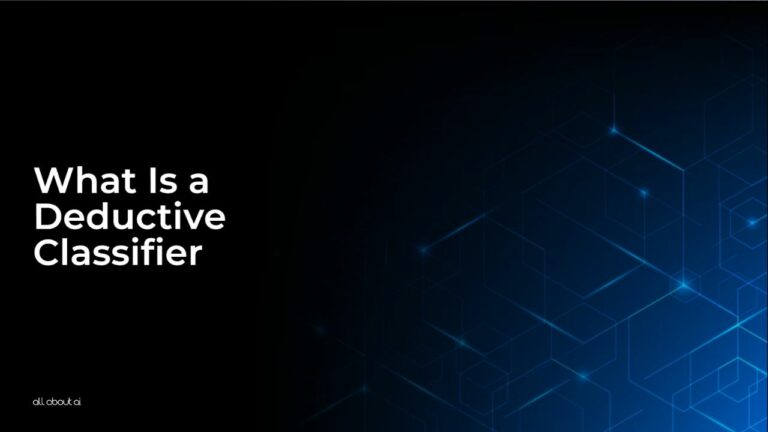A deductive classifier is an artificial intelligence system that utilizes deductive reasoning, a method of reasoning from one or more general statements (premises) to reach a logically certain conclusion.
Unlike inductive classifiers that learn and infer patterns from data, deductive classifiers apply a set of predefined logical rules to categorize or classify data. This method is closely associated with symbolic AI, logical rule-based systems, and knowledge representation.
In this article, we will discuss “What is a Deductive Classifier?” thoroughly, along with its advantages and disadvantages, real-world examples, and everything in between. Why stop? Keep reading this article written by Machine Learning Researchers at All About AI.
Imagine you have a big box of crayons. Each crayon has a label telling you what color it is – like red, blue, or green. Now, imagine you have a rule book that tells you how to sort these crayons into different cups based on their labels. A deductive classifier is like someone using that rule book to sort crayons. It starts with a big idea (like the rule book) and uses it to make decisions on where each crayon should go. It doesn’t guess where to put the crayons by looking at the colors it has seen before; instead, it follows the rules exactly to know where each one belongs. This is different from another way of sorting crayons, where you might look at all the crayons you’ve sorted before and guess where a new one goes based on what you’ve learned from looking at them. That’s what an inductive classifier does – it learns by looking at lots of examples. So, a deductive classifier doesn’t learn by looking at the crayons it’s sorted before. It just uses the rules it was given from the start to sort them correctly. This way of sorting crayons is part of what some smart computer programs do to organize information, using a big book of rules to make sure everything goes in the right place.What Is a Deductive Classifier? The Rule-Following Robot
Contrast with Inductive Classifiers:
Now that you understand the basic concept of “What is a Deductive Classifier?” Explore the distinct differences between deductive and inductive classifiers, understanding how each approach varies in learning patterns and making predictions from data in machine learning.
Learning vs. Application:
Inductive classifiers learn and generalize from data, creating models that predict based on past examples. Deductive classifiers, on the other hand, apply predefined logical rules to new data.
Data-Driven vs. Logic-Driven:
Inductive methods are inherently data-driven and probabilistic, adjusting to new data patterns. Deductive methods are logic-driven, relying on established rules, and are deterministic in nature.
Transparency:
Deductive classifiers offer a clear reasoning path for their decisions, which is often not the case with inductive models where decision-making can be opaque.
Adaptability:
While inductive classifiers can adapt and learn from new data, deductive classifiers are limited to the scope of their pre-established rules.
Consistency:

Deductive classifiers provide consistent results under similar conditions, unlike inductive models that may vary with changes in input data.
The Mechanics of Deductive Classification:
After entailing “What is a Deductive Classifier?” Let’s understand its mechanics in detail.
Deductive classification involves a systematic approach that starts with rule definition and ends with conclusions drawn from the application of these rules.
Rule Definition:
The process begins by establishing a comprehensive set of logical rules. These rules are formulated based on domain expertise, knowledge representation, and symbolic AI principles. The aim is to create a framework that can logically categorize or classify data based on specific criteria.
Rule Application:
Once the rules are defined, they are applied to new datasets. This step involves using computational logic to analyze data points and categorize them according to the predefined rules.
Inference Mechanism:
The system uses inference mechanisms, a cornerstone of expert systems, to draw conclusions based on the rules applied. This involves computational logic that systematically processes data and applies the rules to reach a decision.
Result Analysis:
The outcomes of the classification process are analyzed to ensure they align with the expectations set by predictive analytics. This step is crucial for validating the effectiveness of the rules and the classification system.
Feedback Incorporation:
Based on the results and performance, the rules may be adjusted and refined. This step involves incorporating feedback to improve the accuracy and relevance of the classification system.
Combining Deductive and Inductive Methods:
A hybrid approach that combines deductive and inductive methods can leverage the strengths of both, leading to more robust and adaptable AI models.
Why a Hybrid Approach is Beneficial:
After understanding “What is a Deductive Classifier?” let’s understand why combining deductive and inductive approaches is a better call.
Comprehensive Analysis:
Combining rule-based logic (deductive) with data-driven insights (inductive) enables a more comprehensive analysis, catering to a broader range of scenarios.

Flexibility:
This approach provides the adaptability of inductive models with the clarity and transparency of deductive classifiers.
Accuracy Improvement:
Using both methodologies can enhance the predictive accuracy of AI systems, as it covers both learned data patterns and logical rule-based analysis.
Domain Adaptability:
It makes the system suitable for a variety of domains, from healthcare to cybersecurity, where both data patterns and expert knowledge are crucial.
Balance of Transparency and Adaptability:
Maintains the clarity and transparency of deductive methods while incorporating the adaptability and learning capabilities of inductive models.
Advantages of Deductive Classification:
Deductive classification offers several key advantages, particularly in areas of transparency and domain knowledge incorporation.
- Transparency: The use of clear, logical rules makes the decision-making process transparent and understandable, which is crucial in fields like legal reasoning and healthcare.
- Domain Expertise Utilization: It leverages extensive domain-specific knowledge in rule creation, making it highly effective in specialized fields.
- Predictability: Due to the deterministic nature of the rules, deductive classifiers offer predictable and consistent outcomes.
- Error Analysis: Errors in classification are easier to trace and rectify due to the transparent nature of rule application.
- Consistency: They provide consistent results in conditions similar to those the rules were designed for, ensuring reliability in specific scenarios.
Disadvantages of Deductive Classification:
Despite the advantages, deductive classification also faces several challenges.
- Complex Rule Creation: Developing an extensive set of rules that cover all possible scenarios requires significant domain expertise and can be time-consuming.
- Lack of Flexibility: Deductive classifiers may struggle in situations not foreseen by the existing rules, limiting their applicability in dynamic environments.
- Maintenance: Rules need to be regularly updated to stay relevant, which can be resource-intensive.
- Limited Learning Capability: Unlike inductive models, deductive classifiers do not learn from new data, limiting their ability to adapt over time.
- Dependence on Expert Knowledge: They heavily rely on accurate and comprehensive domain knowledge, which may not always be available or up-to-date.
Real-World Applications of Deductive Classifiers:
Now that you know “What is a Deductive classifier?” here are some of the critical sectors where it is used, offering unique benefits in each.
Medical Diagnosis:
They are used to classify diseases based on symptoms and medical history, utilizing established medical knowledge and guidelines.

Legal Reasoning:
In the legal domain, deductive classifiers help in decision-making by applying statutory laws and legal precedents.
Technical Support:
These systems provide troubleshooting solutions based on a set of technical rules and user-reported issues.
Marketing:
In marketing, they segment customers based on predefined criteria like purchasing behavior and demographics.
Healthcare:
Deductive classifiers personalize treatment plans based on patient data and established medical protocols.
Cybersecurity:
They identify and categorize cybersecurity threats based on known patterns and attack signatures.
Plunge into the universe of artificial intelligence through our thoughtfully composed glossaries. Regardless of your skill level, there’s always something new to uncover!Want to Read More? Explore These AI Glossaries!
FAQs
Here are some of the most commonly asked questions about the topic other than “What is a a Deductive Classifier?”
What is the difference between induction and deduction in machine learning?
Which is better, inductive or deductive method?
What makes deductive classifiers unique in AI?
How do deductive classifiers improve data understanding?
Conclusion:
Deductive classifiers represent a critical aspect of AI, particularly in scenarios where transparency, reliability, and the application of domain expertise are paramount. While they have limitations in terms of flexibility and learning capabilities, their strengths in providing clear and consistent reasoning make them invaluable in many fields.
In this article, we have discussed “What is a Deductive Classifier?” in detail. But this is not the only term we have discussed related to AI. To understand more AI-related terms and concepts, do check out more articles in our AI Knowledge Book.





